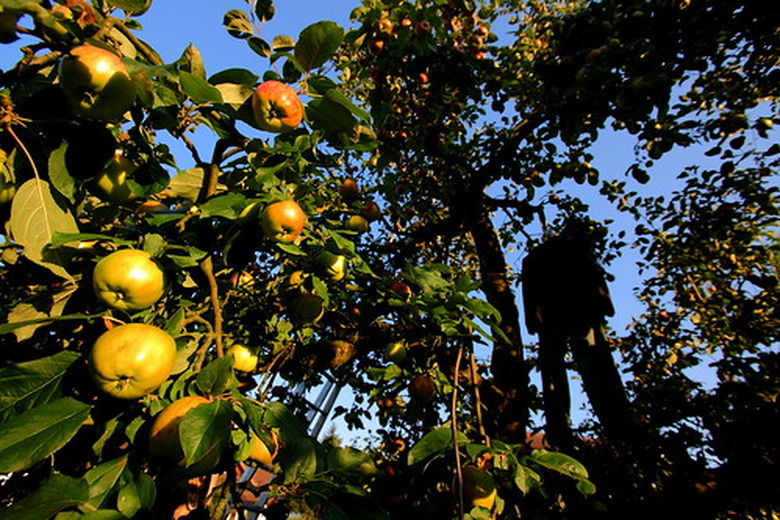What Does An Apple Tree Look Like In The Summer?
We may receive a commission on purchases made from links.
The apple tree is a highly popular fruit-bearing tree. In the summer, an apple tree will be covered with small, green, oval-shaped leaves. If the tree has been pollinated, small, unripe apples will be hanging from its branches.
Identification
Depending on the variety, apple trees can grow between 9 and 40 feet tall. Typically an apple tree grows a wide, dense crown of branches, which are often twisted and knobby.
Apple Breeding
Most apple trees are produced by grafting, or fusing, the stem of one variety of apple tree with the root-stock of another, hardier variety. Sometimes two or even three different varieties are grafted to a single root, resulting in a tree that produces more than one kind of apple.
- The apple tree is a highly popular fruit-bearing tree.
- Sometimes two or even three different varieties are grafted to a single root, resulting in a tree that produces more than one kind of apple.
Warning
Apple trees are vulnerable to a number of common tree infections and insects, such as mildew, aphid infestations, and apple scab. Check your trees frequently through the summer for problem signs, such as white powdery patches, yellow or sickly-looking leaves, and fruit with cracked or bumpy skin.
History
Apples and apple trees are common symbols in Western mythology and religion. In Christian tradition, the "Tree of Knowledge" in the Book of Genesis was an apple tree.
Fun Fact
According to Guinness World Records, the world's heaviest apple was grown in 2005 in an orchard in Hirosaki City, Japan, and weighed just over four pounds.
Trim An Apple Tree?
Many gardeners think of pruning as a way to keep their trees and bushes to a manageable size. Subsequent annual pruning maintains the tree's shape and reduces the fruiting branches to prevent branch breakage and ensure large, healthy fruit. Even as you firm the soil around a young apple whip's roots in your backyard, you should be thinking about training the tree to a strong shape. You can choose between several different pruning systems for apple trees, including open-center, single leader and multiple leader systems. After a young apple tree is trained to a basic shape, you must work to keep new growth from destroying the shape you have given the tree. You should undertake this severe pruning while the tree is dormant, taking care never to remove more than one-third of the canopy in any one year.
- Apple trees are vulnerable to a number of common tree infections and insects, such as mildew, aphid infestations, and apple scab.
- Even as you firm the soil around a young apple whip's roots in your backyard, you should be thinking about training the tree to a strong shape.
References
- "The Apple Grower: Guide for the Organic Orchardist;" Michael Phillips; 2005
- "The Oxford Dictionary of Classical Myth and Religion;" Simon Price et. al.; 2004
- GuinnessWorldRecords.com
- University of California Agriculture and Natural Resources: Fruit Trees: Pruning Overgrown Deciduous Trees
- Harvest to Table: Apple Pruning
- University of California Agriculture and Natural Resources:Fruit Trees: Training and Pruning Deciduous Trees

